The Ghost Monument feels almost worryingly safe.
To be fair, it is almost churlish to complain about this. The Woman Who Fell to Earth seemed designed to assure audiences that the Chibnall Era would be a safe pair of hands, a stylishly produced piece of televisual science-fiction that visually upped the ante in terms of how Doctor Who looked and felt on the small screen. It was consciously designed to be safe and accessible to new viewers, to avoid anything that could be considered weird or strange.

Artful appearance.
By all accounts, this approach paid off. Reviews for the episode were largely positive. The ratings were spectacular, with Jodie Whittaker premiering to a larger audience than any Doctor since Christopher Eccleston and earning the series its highest ratings since the end of the Davies Era. There is a lot to recommend this relatively safe approach to Doctor Who, particularly following the ambition and experimentation of the Moffat Era.
Chibnall is very much adopting a back-to-basics approach. The Woman Who Fell to Earth demonstrated the way such an approach could work. This is the function of premiere episodes, particularly following a regeneration or a significant change behind the scenes. The goal is to comfort audiences still curious whether Doctor Who is the show that they love and to welcome those viewers who might be dipping their toes into the water. Rose and The Eleventh Hour did this as well, constructing tightly-wound accessible thrill rides.

Piecing it together.
However, the question then becomes “what about the second episode?” What happens after the premiere? Having welcomed both old and new audiences into the fold, what does a showrunner do next? In the case of both Davies and Moffat, the answer was to produce something ambitious and messy, something that showcased just how weird and strange the series could be. If the premieres lured viewers in, the following episodes suggested what that audience might be in for; consider the gonzo weirdness of The End of the World or The Beast Below.
The Ghost Monument is a much cleaner and much more streamlined episode than either of those two. It is an efficient action adventure that carries over a lot of the more effective elements of The Woman Who Fell to Earth. However, The End of the World and The Beast Below also suggested just how bizarre and wonderful Doctor Who could be, underneath their messiness. The Ghost Monument is simply effective.

Things went South (Africa) very quickly.
As with The Woman Who Fell to Earth, there is a strong sense that Chibnall is looking back to the Davies Era of Doctor Who as a key influence on his approach to the series. Ignoring the artistic merits of the Moffat Era, this might make a great deal of sense. After all, the series was never as popular as it was during the Davies Era, with David Tennant in the leading role. The Woman Who Fell to Earth included a number of familiar Davies-era cues; an emphasis on family, the Doctor’s profuse apologies those caught in the crossfire, a grounded aesthetic, the Doctor’s dialogue.
The Ghost Monument commits to these comparisons in a number of ways. Most obviously, it suggests a return to the familiar season-opening structure that Davies refined during his tenure, the opening triptych of the present-day premiere, the futuristic adventure and the (usually celebrity) historical: Rose, The End of the World, The Unquiet Dead; The Christmas Invasion, New Earth, Tooth and Claw; Smith and Jones, The Shakespeare Code, Gridlock; Partners in Crime, Fires of Pompeii, Planet of the Ood.
This is a good structure. It very effectively showcases the range of Doctor Who in an accessible and straightforward manner. The series can go forwards in time, it can go back in time, it can be grounded in the present. There is room to be playful in there, room to squeeze in big ideas, but also room to tell stories simple enough to allow character development around the plot point. Moffat even borrowed the structure for his first and last seasons: The Eleventh Hour, The Beast Below, Victory of the Daleks; The Pilot, Smile, Thin Ice.
As such it makes sense that Chibnall would adhere to a similar structure in planning his own first season. The Woman Who Fell to Earth was a very grounded contemporary adventure, while The Ghost Monument is an adventure featuring space ships, robots and laser guns, while Rosa promises a very pointed (and timely) celebrity historical. It’s a robust way of introducing Doctor Who to a new audience or even reintroducing it to an old audience.
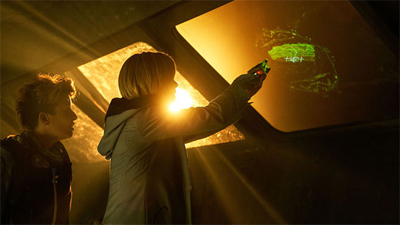
A light touch.
However, the Davies Era influences extend much deeper than this. The Ghost Monument introduces the latest iteration of the TARDIS interior, when the leads arrive in the ship by the end of the episode. The inside of the TARDIS does look more alien than it has in a while, appearing cavernous and almost crystalline. However, it also very consciously evokes the classic coral design that first appeared in Rose, suggesting a much more organic design aesthetic than that of other periods in the show’s history. It also scraps the multi-level design employed during the Moffat Era.
There is something very strange in the way in which The Woman Who Fell to Earth and The Ghost Monument are interpreting the “back to basics” approach as an aesthetic consciously harking back to an era that ended eight years previous. As much as The Ghost Monument might be an adventure set in the distant future, it is also very much a throwback to an earlier era of the series. It feels like the Chibnall Era should have a stronger sense of its own identity out of the gate, particularly given that the prior season existed largely to “keep the TARDIS warm for” Chibnall while he planned out his vision for the series.
To be fair, there are aspects of The Ghost Monument that hark back to earlier iterations of Doctor Who even beyond the Davies Era. The new arrangement of the theme song is consciously less orchestral than those overseen by Murray Gold, and the opening credits feel very much like the classic concept adapted for the twenty-first century, seeming almost like impressionistic interpretations of that the journey on the TARDIS might be like. It looks a lot less generic (and more psychedelic) than the journeys through the vortex depicted during the Christopher Eccleston, David Tennant or Matt Smith years.
There are other similar callbacks to the show’s long and storied history. The Doctor gets to employ some old-fashioned Venusian martial arts, in a manner that might make Jon Pertwee smile. However, the biggest classical influence on The Ghost Monument seems to be the Peter Davison years. To be fair, a lot of this is baked into the premise of the series; a relatively large ensemble cast around a relatively untested iteration of the Doctor.

No Malik of forethought.
However, there are aspects of The Ghost Monument that rather overtly recall Four to Doomsday, the second serial of the Peter Davison era. The image of the Doctor floating through space is common to both The Ghost Monument and Four to Doomsday; even if the Doctor is wearing protection in Four to Doomsday, he looks as naked to the void as his successor in The Ghost Monument. Similarly, the character of Ilin evokes a similar villainous archetype to the Monarch, a villain who is largely physically inactive but whose philosophy horrifies the Doctor.
There is also perhaps something of Enlightenment here, another story about the Doctor blundering into an epic space race. However, Enlightenment serves well as a contrast. There is nothing The Ghost Monument that is as sublimely weird as tall ships sailing through the stars. In fact, The Ghost Monument looks and feels a lot more like any other contemporary television series rather than having the sort of esoteric quality that has always delineated Doctor Who from its fellow genre series.
While certain aspects of The Ghost Monument might look backwards, there is a strong sense within the episode that Chibnall is pushing Doctor Who towards a more contemporary style of televisual storytelling, perhaps in line with other science-fiction series like Black Mirror or Philip K. Dick’s Electric Dreams. This was very clear in The Woman Who Fell to Earth, an episode that embraced a cinematic aesthetic with its distinctive aspect ratio, its use of anamorphic lens, and its tendency towards breathtaking cinematic shots.
The Ghost Monument arguably doubles down on this approach. The South African surroundings provide a suitably cinematic scale, similar to the trip to Lanzarote in The Two Doctors or Dubai in Planet of the Dead, or a handful of other examples across the history of the series. However, it isn’t just the surroundings. It is the way in which the episode is shot and put together. The Ghost Monument spends a significant amount of screentime asking its audience to breath in impressive establishing shots, often with cinematic lens flare adding flavour.

All fired up.
Even in those sequences shot on standing sets, The Ghost Monument suggest that Doctor Who is pushing itself towards a more cinematic visual language. An early claustrophobic sequence between the Doctor and Ezpo in the cabin of his ship is shot on one continuous handheld take, and the actors move around the cramped set and the camera ducks and dives between them. It is a scene that could very easily have been filmed in a less ambitious and stylish manner, but that style seems to be the point of itself. Doctor Who looks cinematic now. Looking cinematic is cool.
After all, the plot of The Ghost Monument is fairly straightforward. It is a race against both time and the elements, with the Doctor leading the cast on a desperate scramble towards a final destination with a ticking clock. This is a fairly reliable plot, as the geographic momentum often carries across the plot and creates a sense of dramatic tension. There are quite a few examples from across the length and breadth of Doctor Who, including episodes like The Doctor’s Daughter and Chibnall’s own 42, mad scrambles across alien environments to save the day.
Indeed, these sequences suggest another classical influence on The Ghost Monument. The “journey through harsh alien terrain” was much more common in the classic series. In particular, it was a narrative device that was frequently used to extend out plots to fill six episodes of airtime. The early episodes of The Daleks might be a good example here, with the characters landing on an alien world and exploring for an extended period before getting to the actual plot of the episode. Indeed, the influence of Terry Nation is keenly felt on The Ghost Monument; the toxic water evokes the acidic seas in The Keys of Marinus.
Quite a lot of The Ghost Monument feels like the “padding” episodes added to some of the original series’ over-extended epic stories; think of the journey through the caves (and facing the giant clam) in Genesis of the Daleks, perhaps the most (in)famous example. This comparison feels quite apt, given that the episode builds to a number of “reveals” of information that will be of use later on; the reveal of the Stenza as the villains of the piece, the hints at “the timeless child.”

Better TARDI than never.
The issue here is that the original series tended to treat dramatic beats like these as padding in a larger story. Indeed, that may well be Chibnall’s intent with this season of Doctor Who, that it should really be treated as a single ten-parter, and so The Ghost Monument becomes a modern day iteration of those early episodes of The Daleks. After all, Chibnall is consciously pushing the series towards a more modern sort of television, and modern television is frequently described as “serialised” or “novelistic.” None of this prevents The Ghost Monument from feeling somewhat empty, narratively speaking.
The Nation parallels are striking in other ways as well. As with a lot of Nation’s writing, the episode is infused with an anxiety about science run amok; any story about scientists creating weapons of mass destruction in the desert inevitably conjures up the nightmare of the atomic bomb, a recurring thematic preoccupation of Terry Nation. (“This planet has been left scorched and barren by our work,” the Doctor reads from the journals of scientists coopted by the military to build instruments of death.)
More than that, The Ghost Monument is stuffed to the brim with details and world-building that don’t necessarily add up to much more than a host of useless information. This sort of detail was a fixture of Terry Nation’s scripts, which often felt guilty of telling rather showing. To be fair, this wasn’t a bad strategy at a point in time when Doctor Who was produced for what Stephen Fry described as “twenty quid and a roll of bubblewrap.” It is somewhat jarring when The Ghost Monument eschews blockbuster scale to go into a great deal of detail on how this world works through exposition rather than illustration.
Given how much attention is paid to how the show looks, it is strange that The Ghost Monument devotes so much attention to verbal exposition. In particular, it is repeatedly stressed how dangerous the water is on the planet. Ilin warns the contestants not to drink (or even touch) the water. The Doctor then confirms that the water is toxic to any life. However, despite the attention paid to how much harm the water can cause, the audience never gets to see it in action. Nobody falls in the water, nobody gets eaten alive by the water. A lot of energy is expended to sell an idea with which the show never does anything.

The killer robots are also a very Terry Nation touch.
This is indicative of some of the strange writing choices in The Ghost Monument, where it feels like Chibnall over-complicates the details of what is a fairly linear and straight-forward plot. For example, the plot hinges on the four main characters being rescued by two different racers, despite floating within metres of one another. However, despite initially splitting the characters up, they are quickly reunited, making that initially separate seem like an unnecessary plot complication.
Similarly, despite all the dialogue that Chibnall writes from the three major guest characters explaining that this is some sort of space race, The Ghost Monument never feels like a space race. Part of this is down to Ilin’s strict warning “no sabotage, no injuries, no killing each other”, which immediately removes both an easy way to generate tension and one of the most obvious plot markers of a space race episode. More than that, there is surprisingly little urgency in The Ghost Monument. There’s never a sense that the characters are actually racing.
The plot of The Ghost Monument could just as easily have been driven by an archeological mission or a religious pilgrimage or almost any other plot motivator. There’s nothing in The Ghost Monument that actually feels like a race. Part of this is down to the fact that the episode only features two racers, and they frequently seem more like professional rivals rather than jockeying athletes. The two racers spend a lot of time in (relative) proximity to one another for characters supposedly trying to leave one another in the dust.
What distinguishes The Ghost Monument from other stories following this same basic literal-race-through-physical-space-against-time narratives is the way in which it is told. Both The Doctor’s Daughter and 42 were filmed on sets. More that, they were filmed on very generic sets, so that the characters could appear to have covered significant amounts of space without needing to construct an impractical number of sets. The Doctor’s Daughter and 42 featured the characters running through similar stretches of interchangeable corridor. Neither was especially cinematic.
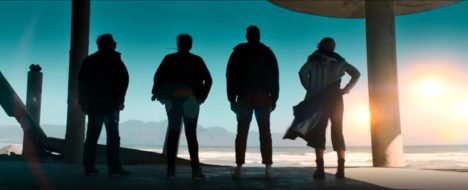
Sands of time.
In contrast, The Ghost Monument applies this old and archetypal template to a more impressive visual style. Once again, the cast are trying to cover daunting geographical distances to reach their destination. However, those treks are not through sound stages. Instead, this journey is an actual journey, one filmed in the wilderness using real physical space to provide a definite sense of scale. When the Doctor has to lead her companions across the desert, The Ghost Monument ensures that the audience actually believes that this is a vast desert rather than a facsimile or illusion. It is visually stunning.
As with the long take within Ezpo’s cabin, this very high production value reinforces the sense that Chibnall is repurposing Doctor Who for the modern televisual landscape, where the line has blurred between film and television. After all, it is very revealing that the season teaser at the end of The Woman Who Fell to Earth rattled off a number of impressive celebrity guest stars, as if to emphasis the series’ production value in a way that extends beyond the location shooting or the anamorphic lens. Alan Cumming! Art Malik! Chris Noth!

You maniacs, you blew it up!
This push towards prestige television is perhaps reflected in the fact that, for the first time, Chibnall has given Doctor Who a traditional writers’ room. This is a very Americanised model of what television should look like, in contrast to the sort of outsourcing-with-editorial-oversight that defined the Davies or Moffat Eras. It seems highly unlikely, for example, that Chibnall could convince a writer like Neil Cross or Neil Gaiman to join a traditional writers’ room in the way that Davies or Moffat might convince them to write a standalone script.
This aesthetic – television as something inherently cinematic and something with more traditional writers’ room – suggests that Chibnall’s tenure might have more conventional long-form serialised arcs involving clearer set-up and pay-off than the Davies or Moffat Eras. Davies and Moffat would seed ideas or plot points across their seasons, but the model of scripting rarely left room for the sort of intricate cross-season plotting associated with contemporary prestige television; modern television might look like a film, but is often likened to a novel. Either way, there is a sense that a single season should be a single story.
The Ghost Monument suggests a much tighter connection to The Woman Who Fell to Earth than most Doctor Who episodes have to one another, in terms of continuity. Even ignoring the idea of the cliffhanger leading directly into the next story in a way that recalls Tom Baker’s first season in the lead role, there’s also a very laboured reference to the Stenza in The Ghost Monument. On an alien world half-way across time and space, the Doctor discovers that the Stenza have been building weapons of mass destruction. These are the same new aliens who appeared in The Woman Who Fell to Earth.
This is a very precise and detailed reference, with the Stenza explicitly identified as the party responsible for weaponising the planet’s eco-system. More to the point, Graham even articulates a personal grudge against them, observing, “My wife died because of them.” Although no Stenza actually appear in The Ghost Monument, the episode seems designed to assure audience members that these aliens were not a one-and-done menace. The audience is warned to keep their ears open for other references, in a manner much more proactive than references to “the Shadow Proclamation” or “Torchwood.”
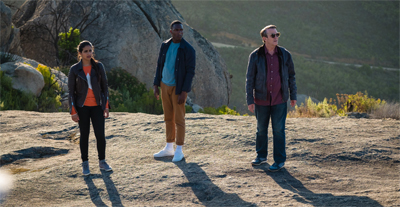
A rocky beginning.
Chibnall has promised that no old aliens will appear in this season, which is probably a good thing. As great as it is to see the Daleks, the Cybermen or the Master, it is also good for the series to occasionally try something new or interesting, to add to the mythos rather than to recycle from it. Davies created the Slitheen and the Ood. Moffat invented the Weeping Angels and the Silence. In theory, it’s good to see Chibnall starting his tenure with a heavy emphasis on a new alien instead of an old one.
However, the Stenza aren’t particularly convincing as antagonists. They worked well enough in The Woman Who Fell to Earth as an enemy species that was not menacing enough to distract from the introduction of a new Doctor, but they weren’t interesting enough to hang a season arc upon. This is particularly frustrating given the obvious debt that these new aliens owe to the creature from Predator or even the Hirogen from Star Trek: Voyager. It seems very much like Chibnall was counting on the release of The Predator to be a much bigger deal than it ended up being.
That said, there is some suggestion of some interesting recurring themes between The Woman Who Fell to Earth and The Ghost Monument. In The Woman Who Fell to Earth, the Doctor boasted of “sorting out fair play across the universe” and called out Tim Shaw on breaking the rules of his hunt. The Woman Who Fell to Earth was a story about a contest with rules, and the breach of those rules. The Ghost Monument returns to that theme with a story built around an intergalactic race, of which Angstrom and Epzo are the last surviving competitors.
Ilin oversees the contest in The Ghost Monument, and is portrayed as someone monstrous. He justifies the incredibly horror of the competition in terms of financial reward. “Biggest ever prize,” he states. “Biggest ever risk.” The Doctor observes on the barbarity of the contest, “Pretty cruel race, leaving the loser stranded.” Ilin suggests that this harshness is a reflection of the universe in which he finds himself. “This entire planet has been made cruel,” he explains.
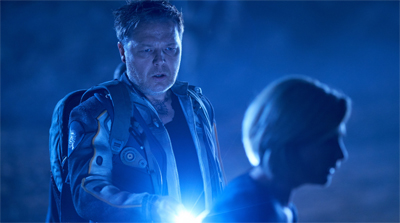
Lighten the mood.
Interestingly, and in something of a contrast to the use of Tim Shaw in The Woman Who Fell to Earth, it is suggested that Ilin is monstrous not for breaking the rules, but for enforcing them. After all, Ilin is arguably a more conventional Doctor Who antagonist than Tim Shaw. Ilin is not a cheater, but a dictator. He imposes rules, some of which even benefit the contestants in his sick game. “No sabotage, no injuries, no killing each other,” he instructs. He recognises joint winners in accordance with the rules of his game. However, Ilin is not a good person.
Instead, the rules simply provide a framework for Ilin’s cruelty, a corrupt system that justifies his barbarity towards others for his own amusement. “Well, I’m sorry I can’t be anymore help,” he tells the Doctor after his exposition dump. The Doctor responds, bluntly, “I don’t think you are.” Ilin concedes that his words were just a gesture towards civility. “You’re right.” At the end of the episode, following the rules, Ilin takes Angstrom and Epzo off the planet by recognising them as winners. Asked to take the Doctor and her companions, he chuckles, “No.” He then maroons them.
This is a much more convincing conventional Doctor Who antagonist than Tim Shaw in The Woman Who Fell to Earth, a much better view of the Doctor’s approach to morality. As much as she might chide Tim Shaw for being a “double cheat”, she is just as horrified by those who play by the rules and enforce systems that inflict sufferings on others. It is the outcome of the process as much as the integrity of the process that matters to the Doctor.
This emphasis on rules and structures plays throughout the episode. “Maybe I don’t play by the rules,” Epzo boasts at one point, pointing a gun in Angstrom’s face. The Doctor has little patience for his posturing. “Nice line,” she observes. “Did you practice those lines in the mirror?” There is a clear sense that unfair systems and unfair rules simply perpetuate cycles of violence and suffering, which is very much a quintessential theme of Doctor Who.

A Lynchpin for the season.
As with The Woman Who Fell to Earth, there is a very faint suggestion that this is all very heavily veiled social commentary on contemporary politics. The Woman Who Fell to Earth raised questions about political victories won by information illegally gathered without people’s informed consent, something that hints at the manipulation of electoral politics in the election of Donald Trump and the vote for Brexit in the United Kingdom.
The Ghost Monument hints towards this reading when the first female Doctor warns Epzo, “Your mom was wrong. We’re stronger together.” That precise framing of words – “stronger together” – evokes the election manifesto of Hillary Rodham Clinton, the first major female candidate for President of the United States, and a woman who failed to win the presidency despite securing the majority of votes because of the vagaries of the system.

Bot war.
More to the point, the world-building within The Ghost Monument suggests that the race might be best red as a metaphor for survival in modern capitalism, particularly for those trying to break in from the outside. Angstrom is explicitly characterised as a refugee trying to find a life for her family by doing something incredibly risky, playing a cruel game on a cruel world for even the chance to lift her family out of hell.
“We start the race with nothing and work our way up,” she explains, in what might easily be read as a metaphorical articulation of the American Dream as seen by immigrants from around the world. Trying to explain why she would risk everything for this mission, Angstrom confesses that her homeworld “is being systemically cleansed.” The language is striking, evoking genocide and the belief held by some supporters of the current United States administration that the country needs to be subjected to a “peaceful ethnic cleansing.”
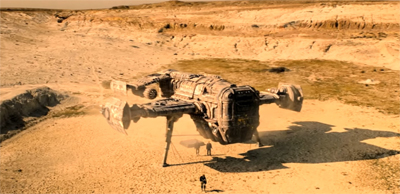
Sticking the landing.
As such, The Ghost Monument hints at the current charged political climate rather than addressing it overtly. The Ghost Monument touches on systems of cruelty, whether in capitalist structures or even within immigration frameworks. However, there is a sense that these metaphors could be more clearly articulated. Chibnall might be borrowing a lot from Davies, but his political commentary is much less oblique and overt. There is nothing here compared to the United States President in The Sound of Drums or the murder of Tony Blair in Aliens of London and World War Three.
To be fair to Chibnall, this probably makes sense given that audience might be suffering from politics fatigue in an era when everything is about politics. On the other hand, when dealing with themes like how corrupt systems victimise refugees from genocidal regimes, it is probably better to be overt than to be implicit; to tie the idea directly back into the current crisis in a way that underscores the inhumanity of separating parents from children or refusing amnesty to those who are facing death.
The Ghost Monument demonstrates again that Chibnall isn’t as good with dialogue as Davies or Moffat. The writing in The Ghost Monument is functional and efficient. A lot of the dialogue serves to drive the story or the emotional beats, rather than existing as something to be celebrated of itself. The story is full of set-up and pay-off, with the Doctor often explicitly articulating big questions to keep the audience engaged. “Why would you need robot guards on a deserted planet?” she wonders right before the cut at the end of the scene. Inevitably, the question is answered.
It isn’t that Davies and Moffat avoided that sort of heavy-handed set-up and pay-off dialogue; it may be impossible to write a show like Doctor Who without indulging in that sort of writing. The issue with that Chibnall is not as good at disguising it or burying it between genuinely engaging and playful exchanges. This is particularly true with the set-up of all the elements necessary to destroy the Remnants at the end of the episode, each of which – the atmosphere, the cigar – gets a lot of very clumsy set-up before coming together. It’s effective, if inelegant.

Whorp speed ahead.
This is perhaps the biggest issue with The Ghost Monument. The story is very much a straight line, in terms of plotting and in terms of geography. The Doctor has to get back to the TARDIS, and so becomes embroiled in a deadly space race. However, there’s no real energy or verve to the story, no big central idea. Even the episode’s political or social themes are very much tucked away at the edges of what is a very straightforward narrative. It feels very conventional.
This puts The Ghost Monument in a very strange position compared to its obvious counterparts; The End of the World or The Beast Below. In some ways, The Ghost Monument is a cleaner and more straightforwardly accessible narrative than either of those; there is no space whale, no murderous mannequins, no Moxx of Balhoon, no Forrest of Cheem, no Face of Boe, no absurdly heightened allegory for the complicity that voters have in the chaos of contemporary democracy, no celebration of the end of the planet earth.
However, there’s also a clear absense in The Ghost Monument, an empty space where this weirdness is supposed to go. Everything has been streamlined and tidied. There is little here that would be considered embarrassing or could potentially turn the show into a subject of mockery. There’s nothing especially risky or gonzo in The Ghost Monument, just generic science-fiction production design around a fairly conventional plot. For all its messiness, The Beast Below weirdly feels like it has more to say on the modern world than The Ghost Monument.
Doctor Who probably looks better in The Ghost Monument than it has at any point in its history. However, it also looks decidedly less strange and playful. If is indicative of the Chibnall era, it will be a great loss.
You might be interested in our other reviews from Jodie Whittaker’s first season of Doctor Who:
- The Woman Who Fell to Earth
- The Ghost Monument
- Rosa
- Arachnids in the U.K.
- The Tsuranga Conundrum
- Demons of the Punjab
- Kerblam!
- The Witchfinders
- It Takes You Away
- The Battle of Ranskoor Av Kolos
- Resolution
Filed under: Television | Tagged: art malik, brexit, Chris Chibnall, doctor who, jodie whittaker, race, the doctor, the ghost monument, trump |




















Great analysis as usual. I’m getting a bit more concerned now. If this is a sign of things to come for the Chibnall era, I’ll quickly lose interest. RTD may have had his flaws as a writer, but he was a fantastic showrunner. Moffat may have had his flaws as a showrunner, but in terms of great episodes, few Who writers have ever written as many as him. I don’t feel like Chibnall’s great at either. He’s, as you say, functional at both. And functional isn’t what I come to Doctor Who for.
Yep, I’d co-sign on this, although I get the sense I’m fonder of Moffat than you are.
I don’t think so. I prefer it to the Davies era overall, and I really like Series 5, 9 and 10, and like 6 and 8. It’s only 7 I really have a problem with. Davies’ are all inconsistent, with 1 and 4 being slightly less inconsistent than 2 and 3. I can see why people like Davies more, but I don’t.
Ah, cool.
Yeah, I can see that. (That is why I’m more disappointed than angry at Chibnall pushing the show so strongly back to the Davies-era template.)